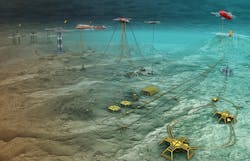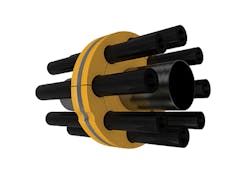Carbon fiber extending options for deepwater production systems
Potential benefits include lower riser installation costs
Stephen Hatton, David Charlesworth
Magma Global
Low oil prices and the emergence of US shale have put pressure on deepwater field development. The offshore industry’s response has been to look for technologies that can enable cost savings and reduce the time to first oil for deepwater reserves, particularly those in harsh conditions.
This has led to a growing interest in the use of thermoplastic composite pipe (carbon fiber) for risers, flowlines and jumpers, and various designs are either under development for future use. The next generation of risers are designs enabled by materials technology, which will set the industry on the path to a future where composites become commonplace in subsea infrastructure.
Why carbon fiber?
The main benefits of carbon fiber over steel are its corrosion resistance and strength to weight ratio. Carbon fiber is typically 20 times stronger than steel for the equivalent weight. Broadly speaking, anything you can do with steel you can do with carbon fiber. However, carbon fiber also enables a different and more efficient alternative to steel and non-bonded flexible riser architectures.
Any riser concept based on carbon fiber pipe has an inherent corrosion resistance advantage, however not all the polymers that form the inner surface and matrix of a carbon fiber pipe are resistant to all types of chemicals. PEEK is a particularly attractive polymer as it is not subject to any degradation from oil field chemicals in particular hydrogen sulfide (H2S) and carbon dioxide (CO2) which are especially challenging for steel structures. PEEK also gives the pipe high temperature capability and its very low permeation makes it well suited to gas applications.
Automated production process for carbon fiber and PEEK pipe shown in Magma’s in-country manufacturing module. (Courtesy Magma Global)
Carbon fiber pipes are a fraction of the weight of existing pipe technologies: this presents significant opportunities in riser design, as the high-performance materials make it possible to construct a much smaller, lighter structure. Because the carbon fiber is so strong the pipes require less material to deliver the pressure performance, which in turn keeps the cost down. However, the real savings come from installation. As carbon fiber pipe is very light it does not require buoyancy and can be deployed from small vessels that can be hired at a fraction of the cost of large pipelay vessels. The extent of the benefits from the low weight will depend on the application and the chosen configuration in the water column.
Catenary-mode hybrid
TechnipFMC is working on a riser solution in a free-hanging catenary configuration design that will integrate a carbon fiber PEEK pipe structure into a traditional flexible pipe. The aim is to deliver a hybrid that has sufficient flexibility and the required submerged weight to be configured in a free-hanging configuration, even in ultra-deepwater. The hybrid flexible exploits the benefits of carbon fiber pipe in terms of its light weight and corrosion resistance.
Carbon fiber pipe’s low weight is particularly beneficial in this case because a conventional design requires added buoyancy to reduce its top tension, the weight hung off the vessel. By replacing part of TechnipFMC’s existing product with carbon fiber pipe, it becomes much lighter but with the same strength, thereby eliminating the need for large buoyancy modules that are expensive both to buy and install. The riser design is also very similar to TechnipFMC’s existing product in terms of handling and can therefore be run from existing vessels and infrastructure without the need for expensive modification.
TechnipFMC’s Subsea 2.0 vision. (Image courtesy TechnipFMC)
Composite multi-bore hybrid risers
Ocyan’s CMHR riser design exploits many of the benefits of carbon fiber pipe resulting in an ultra-light solution which de-couples the subsea architecture from the delivery of the FPSO and in so doing reduces project risk and timescale. The design is made possible by the light weight of carbon fiber pipe and employs a steel backbone tensioned by a buoyancy canister. In one example, eight carbon fiber riser pipes are integrated with the steel backbone to form a static column from the seabed to just beneath the sea surface. The final connection to the FPSO is affected through a dynamic jumper. The entire riser structure is constructed onshore and towed to site, then up-ended. Using carbon fiber instead of steel pipes also means the pipe can be installed from reels rather than being welded, with associated benefits in terms of the size of yard needed for construction and the time taken to construct. Furthermore, the design makes use of a qualified product, eliminating the untested and unknown.
Single leg hybrid risers
A carbon fiber SLHR design is another form of hybrid riser that is both lightweight and fatigue resistant. As with the CMHR this riser design uses carbon fiber to replace steel pipe in the vertical portion of the hybrid riser. The carbon fiber pipe spans the water column from the seabed to just below the surface where it is connected to a small buoyancy module. The flow path then continues to the surface through a dynamic flexible jumper. The SLHR configuration uses the minimum amount of carbon fiber pipe and therefore provides a very cost-effective solution. It is suited to any deepwater basin and like the CMHR de-couples the subsea architecture installation from the arrival of the host facility. However, the qualification requirements for an SLHR are more onerous than for a CMHR, as the loads the carbon fiber pipe must resist are more complex and an SLHR typically requires larger diameter pipe. These factors suggest this riser configuration will take longer to introduce to the market.
In this design the pipe is no thicker. Its strength comes from the way the fibers are aligned with the loads. Where high tension capacity is not required a lay angle is employed for the carbon fiber, optimized for pressure. However, if higher tensions are required then the lay angle can be adjusted accordingly, although this has the downside of increasing the minimum bend radius for reeling and deployment. One way to get around this is to tow out the pipe and then upend it, rather than deploy from reels from a vessel.
Section detail of Ocyan’s Composite Multibore Hybrid Riser design. (Courtesy Ocyan)
Long distance step-out
In Ghana, Magma is working with a forward-thinking idea for a deepwater riser design with a long step-out of around 10 km (6.2 mi). The driver is to avoid laying any infrastructure on the seabed to get around the challenges of geohazards. Traditionally a pipe is run straight down to the seabed, where a manifold is put down, then runs a pipe to the well. This requires survey work, installing piles and crossing trenches and hills on the seabed. If the gradient is gentle and relatively consistent it becomes easier to run tools down the pipe for well intervention and avoid the need to deploy a vessel. In Ghana, where the pockets of oil are spread out in different places and are relatively small, it makes sense to avoid laying anything on the seabed. In this case the carbon fiber risers could be removed after just a few years of production and re-used at the next reservoir without the need for re-engineering or detailed seabed surveys.
The problem with this design is a very long length of pipe floating in midwater, where currents can potentially cause a problem. Carbon fiber pipes have a very low specific gravity and will require a small amount of buoyancy and ballast and possibly simple tethers to the seabed to achieve a stable configuration. However, this is not a huge challenge as carbon fiber is fatigue resistant and can handle gentle flexing from water movement. This approach makes small, spread-out reservoirs more economically viable.
However, the carbon fiber design will need to be developed and there is a process safety issue to consider. This concerns the hydrocarbon inventory in the riser which would be substantial given the long step-out distance. This may need to be managed with intermediate valves but would require further engineering. Technically it appears this concept will work but there are complexities to address, and it will take time.
Carbon fiber SLHR concept. (Courtesy Magma Global)
Carbon fiber catenary designs
Subsea 7 and Airborne recently announced that they are investigating a rise concept in a free-hanging catenary design that will use thermoplastic composite pipe (TCP). They revealed that this would most likely use PVDF and carbon fiber and that they intend to use a weight coating to make it a heavier pipe than would be the case naturally. In a gas system a pure TCP pipe will simply float which is not a great characteristic for a subsea pipe. Additional weight will be needed to provide stability both on the seabed and in the water column, and there will be a need for a laminate design that will induce a large-bend radius. It may offer advantages, but this design suggests that the stored volume of pipe will be larger than that of current pipe designs and this will inevitably require a change to installation vessel infrastructure. This solution appears unlikely to be adopted quickly in the Brazilian market, where installation infrastructure is geared up for non-bonded flexibles, so an efficient installation method will be needed; if you change the reel size it potentially invalidates a lot of the existing fleet in Brazil.
The oil and gas industry operates with low price constraints and this situation will persist for many years. New solutions must prove themselves to be cost-effective and reliable. Opex is the quiet profit killer: frequent interventions, loss of production, and failures late in life due to degradation can be catastrophic. Operators will often sell off an asset at a low price in its later life in order to offload a potentially unreliable liability. These new carbon fiber riser designs prove to be invaluable in removing the various unknowns.
Composite Multibore Hybrid Riser design. (Courtesy Ocyan)
However, it is important for market adoption for early designs to work within existing infrastructure. While opex and capex combined can come down significantly through use of carbon fiber, the way operators separate their teams means it is all about the cost of getting to first oil at the purchase stage. Opex costs are often not fully reported so configurations that minimize the lengths of carbon fiber required will probably be adopted first.
The world is developing cleaner fuels and the pressure to not use oil and gas will increase. The industry will become even more price sensitive and reliability driven. Oil companies will most likely be keen to only exploit massive finds and not the smaller fields. Even so there are thousands upon thousands of kilometers of flexible pipe out there that will need replacing before the end of their lifespan. This should lead to growing market acceptance that carbon fiber designs are better in terms of reliability, with a long-term performance, while remaining cost effective. •
The authors
David Charlesworth is a specialist in riser pipes and all forms of riser design, analysis and integrity management, and has an in-depth knowledge of turret systems. His career has included working for both contractors and operators on projects in different regions of the world. Prior to joining the offshore industry, he studied for a doctorate in computational fluid dynamics and completed two years of post-doctoral research.
Stephen Hatton has wide experience in the international offshore oil and gas industry with a focus on deepwater production systems and riser technology. He works with Magma Global to develop and commercialize carbon fiber pipe technology for deepwater riser applications worldwide. Previously he joint-founded 2H Offshore, a specialist deepwater riser engineering company.





